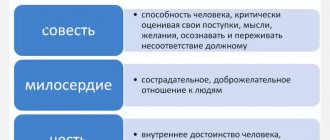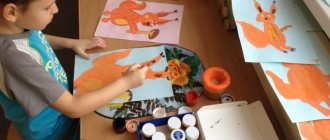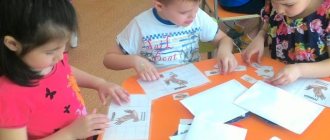Card index of role-playing games for spiritual and moral education for preschoolers
— Game "Generous Gifts"Goal: developing the ability to perceive goodness, justice and generosity. Distribution of roles: One child - Fairy of Generosity. The rest of the children receive different letters and remember them.
Progress of the game:
Children spin around to the music. When the music stops, the children freeze.
The "Generosity Fairy" touches someone with her magic wand. At the same time, the child names his letter. The “Fairy of Generosity” must come up with what kind of generous gift she has prepared for a given letter. For example, she will give someone with the letter “Z” an umbrella so that he doesn’t get wet in the rain, or a bunny so that he can play with it. If the “Fairy of Generosity” cannot come up with a gift herself, those children whom she has already “revived” help her.
— Game “True Friends”
Goal: developing the idea of mutual assistance and friendliness.
Progress of the game:
Divide the room into two parts with chalk or ropes. One part is land, the other is sea. Children hold hands and walk in a circle to the music.
When the music stops, everyone stops. Those children from the circle who find themselves on “land” must save those who find themselves in the “sea”. To do this, children perform various tasks that the teacher offers them.
The task of the children is to save their children as quickly as possible.
— Game “How to take care”
Goal: developing ideas about goodness, love and care.
Progress of the game:
Children stand in a circle. The teacher goes around the circle and places different toy animals in the hands of the children, and then names one toy animal, for example, a cat. The one who has the cat in his hands goes to the middle of the circle and asks the children to take turns telling how to take care of the cat. The child in the center of the circle gives his toy to the one whose story he liked the most.
— Game “Only Good”
Goal: to develop in children an idea of goodness; development of oral speech: creative thinking, imagination.
Progress of the game:
The teacher, with a ball in his hands, stands in front of the children, asks them to line up, and then throws the ball to each of them. Children catch the ball only when the teacher pronounces some good quality (truthfulness, kindness, accuracy).
In this case, they take a step towards the teacher. If children accidentally “catch a bad quality” (intolerance, greed, anger), they take a step back. The one who reaches the teacher first wins. This person becomes the leader.
— Game “Favorite quality”
Goal: to develop in children an understanding of the phenomena of reality from the standpoint of moral and ethical standards.
Ask the children to sit in a circle and invite them to think about their favorite quality. Then, one by one, the children name their favorite quality.
If a certain quality is liked by the majority of children, that quality is invited to settle in the group. He is given a beautiful chair, which becomes the chair of kindness, caring, observation or courage. In the future, any child who wants this quality to grow in him can sit on a chair of one quality or another. Also, if one of the children behaves badly, cries, or does not listen well, the teacher invites him to sit on a chair of one quality or another. Children can choose a new quality every week and invite it to live in their group.
— Game “Beauty Ring”
Goal: assistance in the formation of the child’s personality, his social and moral relations with the outside world through the development of the best qualities.
Progress of the game:
Tell the children that you have a beauty ring. As soon as you point the ring at any person, all the most beautiful things in him immediately become visible. Children stand in a circle and extend their folded palms forward. The teacher discreetly places a ring in someone’s hands. Then the children shout in unison: “Ring, ring, go out onto the porch.” The person who receives the ring runs out to the middle of the circle. He should touch his friends with the ring and tell him what beautiful things he sees in them. The one who sees the most beauty in his friends receives a beauty ring as a gift.
— Game “Circle of Honesty”
Goal: formation of social and moral relationships with the outside world through the development of the best qualities - the child’s honesty.
Progress of the game:
Children are divided into two teams.
Members of one team stand in a circle and, holding hands, raise them up. This is the circle of honesty. The second team forms a chain, one after another, running in and out of the circle of honesty like a stream to the sound of cheerful music.
When the music stops, the children forming a circle of honesty lower their hands and do not let anyone out of the circle. Those who remain in the circle take turns talking about some honest deeds.
Then the teams change places.
— Game "Magic Wand"
Goal: to cultivate in children a sense of mutual assistance and cooperation, the development of coherent speech.
Progress of the game:
Children stand in a circle and take turns recalling a situation when they needed help.
For example: bad mood, toothache, offended someone, didn’t buy a new toy. The teacher has a beautiful magic wand in his hands.
When the first child talks about his problem, the teacher says: “Lifesaver, help! Help a friend out of trouble!” The child who knows how to help a friend in trouble raises his hand, and the teacher gives him a magic wand. This child touches his friend with a stick and tells him how he can help him.
If none of the children know how to help their friends, the teacher himself touches this or that person with a magic wand and tells the children how they can help a friend out of trouble.
— Game “Life in the Forest”
Goal: education of moral and volitional personality traits in children of senior preschool age.
Progress of the game:
Teacher (sits on the carpet, seating the children around him): Imagine that you find yourself in the forest and speak different languages. But you need to communicate with each other somehow. How to do it? How to ask about something, how to express your friendly attitude without saying a word? To ask a question, how are you doing, clap your palm on your friend’s palm (show). To answer that everything is fine, we tilt our head to his shoulder; we want to express friendship and love - we affectionately stroke the head (show). Ready?
Then we started. It’s early morning, the sun is out, you just woke up...
The teacher unfolds the further course of the game at random, making sure that the children do not talk to each other. Communication without words eliminates quarrels, disputes, contracts, etc.
— Game “Good Elves”
Goal: education of moral and volitional personality traits in children of senior preschool age.
Progress of the game:
Teacher (sits on the carpet, seating the children around him): - Once upon a time, people, fighting for survival, were forced to work day and night. Of course, they were very tired. The good elves took pity on them.
As night fell, they began to fly to people and, gently stroking them, lovingly lull them to sleep with kind words. And people fell asleep. And in the morning, full of strength, they set to work with renewed energy. Now we will play the roles of ancient people and good elves. Those who sit on my right hand will play the roles of these workers, and those on my left will play the roles of elves. Then we will switch roles. So, night came. Exhausted from fatigue, people continue to work, and kind elves fly in and lull them to sleep...
A wordless action ensues.
— Game “Chicks”
Goal: education of moral and volitional personality traits in children of senior preschool age.
Progress of the game:
Educator: - Do you know how chicks are born? The embryo first develops in the shell. After the allotted time, he breaks it with his small beak and crawls out. A big, bright, unknown world opens up to him, full of mysteries and surprises. Everything is new to him: flowers, grass, and shell fragments. After all, he had never seen all this. Shall we play chicks? Then we’ll squat down and start breaking the shell. Like this! (Show.) That's it! They smashed it! Now we’ll explore the world around us - let’s get to know each other, walk around the room, sniff the objects. But keep in mind that chicks cannot talk, they only squeak.
— Game “Ants”
Goal: education of moral and volitional personality traits in children of senior preschool age.
Progress of the game:
Teacher (seating the children around him).
“Have any of you ever seen an anthill in the forest, inside of which life is seething day and night? None of the ants sit idle, everyone is busy: some carry needles to strengthen their homes, some prepare dinner, some raise children. And so all spring and all summer. And in late autumn, when the cold sets in, the ants gather together to sleep in their warm house. They sleep so soundly that they are not afraid of snow, blizzards, or frosts. The anthill wakes up with the onset of spring, when the first warm rays of the sun begin to break through the thicket of needles. But before starting their usual working life, the ants throw a noble feast. I have this proposal: the role of ants on a joyful holiday day. Let's show how the ants greet each other, rejoicing at the arrival of spring, and how they talk about what they dreamed about all winter. Just don’t forget that ants can’t talk. Therefore, we will communicate using gestures.”
The teacher and children act out the story told through pantomime and actions, ending with a round dance and dancing.
— A variant of the folk game “One, two, three run!”
Goal: formation of strong-willed qualities and mastery of one’s behavior.
Features of the game: - the child must choose his own partner, thus getting the opportunity to express sympathy to one of his peers.
Description of the game and how to play it:
“Let's see which of you can run fast!” - the teacher addresses the children. He invites everyone to hold hands and form a nice, even circle. Children lower their hands and sit on the floor (if the game is played indoors) facing inside the circle. The teacher, being behind the circle, goes around him, saying:
- The fire is burning, the water is boiling, you will be washed today. I won't catch you! The children repeat the words after him. On the last word, the adult touches one of the children, asks him to stand up, turn to face him, and then says: “One, two, three - run!” The teacher shows in which direction you need to run around the circle in order to be the first to take the vacant seat. The teacher and the child run around the circle from different sides. The adult gives the child the opportunity to be the first to take an empty seat and again becomes the driver. He goes around the circle again and repeats the words, giving the children the opportunity to remember them and get used to the rules of the new game. Having chosen another child, the adult this time tries to be the first to take a place in the circle. Now the child becomes the driver and chooses his own competition partner. The winners are rewarded with applause. So, in turns, the children compete with each other.
Rules of the game.
1. Choose as a partner someone who has never run before.
2. Run in a circle in opposite directions.
3. The one who did not have time to take a place in the circle becomes the driver.
— The Fox and the Geese (Variant of the folk game)
Goal: to create a desire to help others.
Features of the game and its educational value:
- contributes to the development of organization in children, the ability to manage their behavior in a team.
— The child’s task is not only to avoid danger himself, but also to help out the one who was caught by the catcher (fox).
Description of the game and methods of its implementation.
The whole group takes part in the game. A child is chosen to play the role of a fox who will catch geese. The rest of the children portray geese, whose owner is the teacher.
An adult draws two lines on the ground at a distance of 25 - 30 steps. Behind one of them is the house of the owner and the geese, and behind the other is a meadow where geese graze. The circle represents the fox's hole. The game begins.
The owner escorts the geese to the meadow. For some time the birds walk freely, nibbling grass. At the call of the owner, who is in the house, the geese line up at the line (the border of the meadow), and the following dialogue takes place between them:
Master. Geese-geese!
Geese. Ga-ga-ga.
Master. Do you want to eat?
Geese. Yes Yes Yes!
Master. Well, fly!
The last phrase is a signal: the geese run to their owner, and the fox catches them.
When the fox has molested two or three geese (touches them with her hand), she takes them to her hole. The owner counts the geese, notes which ones are missing, and asks the children to help the goslings in trouble. All participants in the game, together with the teacher, approach the fox hole.
All. Fox-fox, give back our goslings!
Fox. Will not give it back!
All. Then we ourselves will take them away from you!
The teacher invites the children to stand behind him “in single file” and tightly grab each other by the waist. "Cling to me!" - says the owner. He approaches the fox, takes her by the hands and says, turning to the geese: “Hold on tight. Pull - pull. Wow! All participants in the game, resting their feet and holding each other, move their body back to the words of the teacher “pull” (two or three times).
As soon as the fox, under pressure from this chain, takes the first step forward, the caught geese run out of the hole and return home. Then a new fox is chosen and the game starts all over again.
Rules of the game:
1. The geese run home, and the fox is allowed to catch them only after the owner says, “Well, fly.”
2. The fox should not grab the geese, it is enough to just nag the running child. The caught goose remains in place, and the fox takes it to its hole.
3. All participants in the game go to the rescue of the caught geese.
At the end of the game the result is summed up. The teacher explains to the kids that they helped out their friends because they acted together, all together.
Used Books:
1. Zaporozhets A.V. The World of Childhood. Preschooler. M.: Pedagogika, 1987. 416 p.
2. Loginova V.I., Samorukova P.G. Preschool pedagogy. M.: Education, 1991. 63 p.
3. Podlasy I. P. Pedagogy. M.: Humanit, 2000. 256 p.
4. Friedman L. M. Psychology of children and adolescents: a reference book for teachers and educators. M.: Institute of Psychotherapy, 2005. 480 p.
5. Alyabyeva E. A. Moral and ethical conversations and games with preschoolers. M.: TC Sfera, 2003. 128 p.
6. Boguslavskaya Z. M., Smirnova E. O. "The role of play in the moral development of a child." M.: “Enlightenment”, 1991.





